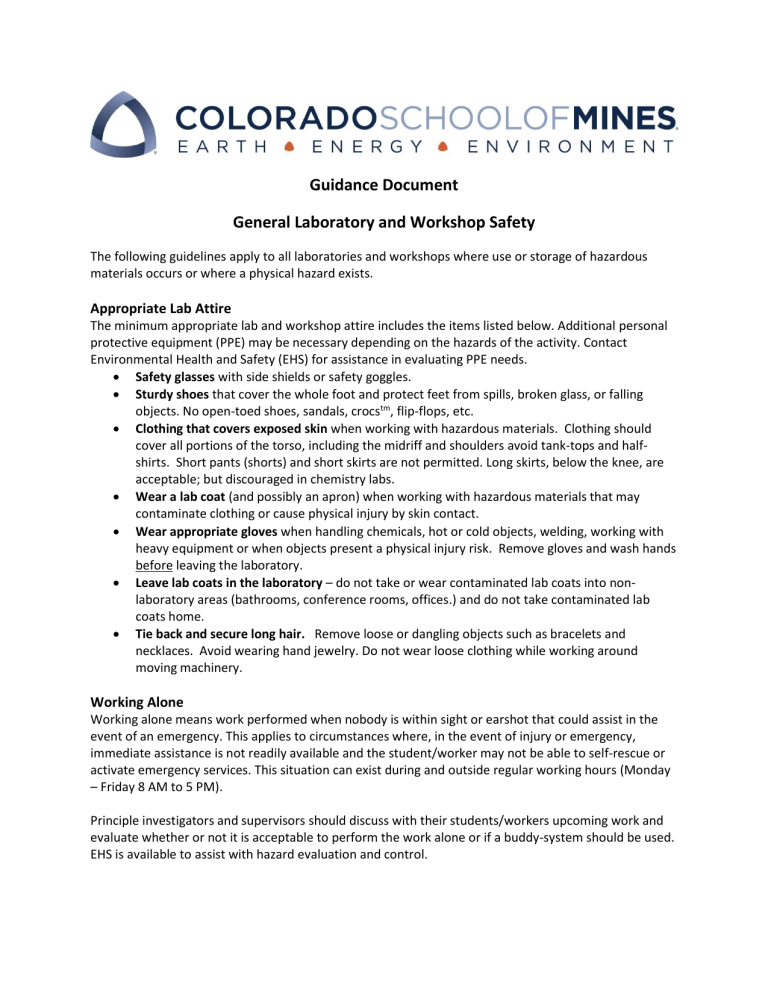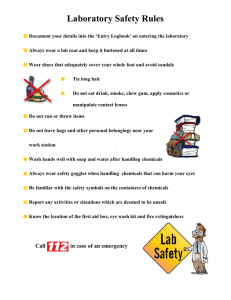Guidance Document General Laboratory and Workshop Safety

Guidance Document
General Laboratory and Workshop Safety
The following guidelines apply to all laboratories and workshops where use or storage of hazardous materials occurs or where a physical hazard exists.
Appropriate Lab Attire
The minimum appropriate lab and workshop attire includes the items listed below. Additional personal protective equipment (PPE) may be necessary depending on the hazards of the activity. Contact
Environmental Health and Safety (EHS) for assistance in evaluating PPE needs.
Safety glasses with side shields or safety goggles.
Sturdy shoes that cover the whole foot and protect feet from spills, broken glass, or falling objects. No open-toed shoes, sandals, crocs tm , flip-flops, etc.
Clothing that covers exposed skin when working with hazardous materials. Clothing should cover all portions of the torso, including the midriff and shoulders avoid tank-tops and halfshirts. Short pants (shorts) and short skirts are not permitted. Long skirts, below the knee, are acceptable; but discouraged in chemistry labs.
Wear a lab coat (and possibly an apron) when working with hazardous materials that may contaminate clothing or cause physical injury by skin contact.
Wear appropriate gloves when handling chemicals, hot or cold objects, welding, working with heavy equipment or when objects present a physical injury risk. Remove gloves and wash hands before leaving the laboratory.
Leave lab coats in the laboratory – do not take or wear contaminated lab coats into nonlaboratory areas (bathrooms, conference rooms, offices.) and do not take contaminated lab coats home.
Tie back and secure long hair.
Remove loose or dangling objects such as bracelets and necklaces. Avoid wearing hand jewelry. Do not wear loose clothing while working around moving machinery.
Working Alone
Working alone means work performed when nobody is within sight or earshot that could assist in the event of an emergency. This applies to circumstances where, in the event of injury or emergency, immediate assistance is not readily available and the student/worker may not be able to self-rescue or activate emergency services. This situation can exist during and outside regular working hours (Monday
– Friday 8 AM to 5 PM).
Principle investigators and supervisors should discuss with their students/workers upcoming work and evaluate whether or not it is acceptable to perform the work alone or if a buddy-system should be used.
EHS is available to assist with hazard evaluation and control.
Examples of work that should not be performed alone include changing out toxic gas cylinders, working with pyrophoric materials outside of a glovebox, working with shock sensitive materials, working on energized electrical systems with exposures greater than 50 volts, entering a confined space, working around mechanical equipment with exposed rotating parts (e.g. lathe, roller mill or power saw), working with concentrated (≥ 48%) hydrofluoric acid or working with highly exothermic reaction systems (e.g. polymerizations, oxidations, or hydrogenations).
Food and Beverages
Do not consume or store food or beverages in labs or workshops.
Access Control
Follow the Mines Building Access Policy for authorized entry to laboratories only. Authorized entry means with the permission of the Principal Investigator, Lab or Workshop Director, and other Mines required policies relating to restricted access. Laboratory and workshop doors must be locked when not occupied. Doors must not be propped open - propping doors may allow unauthorized access to hazardous areas and may compromise fire protection and air handling (HVAC) function.
General Chemical Safety Guidelines
Minimize chemical exposure- o Avoid skin contact as much as possible. o Wear eye protection where chemicals are used. o Verify there is adequate ventilation. o Wear appropriate gloves for the hazards. o Wear lab coats and other protective clothing. o Do not eat or drink in the lab. Do not apply cosmetics, lip balm. o Wash hands after removing gloves and before leaving the lab. o Don’t pipet or start a siphon by mouth. o Keep personal belongings away from chemicals.
Be knowledgeable. Do not underestimate risk- o Obtains and read safety data sheets prior to initial handling of a chemical. o Assume that any unfamiliar chemical is hazardous. o Consider mixtures to be as hazardous as any component. o Know the emergency procedures for the lab, department and building. o Know location of emergency shower, eyewash station and first aid kit.
Use proper engineering controls and safe procedures- o Substitute less hazardous chemicals when practical. o Verify there is adequate ventilation. Use laboratory hood and/or glove box when openly handling hazardous chemicals. o Label all chemical containers. o Keep work areas clean and uncluttered.
Document Control Log
Revision # Revision Description
1 Initial issue
2 Added appropriate lab attire, food and beverage, access control and working after hours information
Date
8/7/2012
6/12/2015



